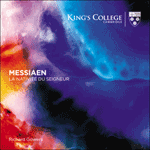
Welcome to Hyperion Records, an independent British classical label devoted to presenting high-quality recordings of music of all styles and from all periods from the twelfth century to the twenty-first.
Hyperion offers both CDs, and downloads in a number of formats. The site is also available in several languages.
Please use the dropdown buttons to set your preferred options, or use the checkbox to accept the defaults.

| Richard Gowers (organ)» More |
One notable aspect of the sensuality in Messiaen’s music was his distinctive array of modes, whose symmetries and cyclic properties lend a floating, suspended quality to both harmony and melody that can become hypnotic, especially at a slow tempo. He discovered these modes early on, and in the orchestral L’Ascension (1932-33) they are sculpted into the first of Messiaen’s grand religious designs: four movements which lead the listener on a broad arc from expectancy to exultation. The arrangement of this work for organ (1934, including a new and exhilarating third movement) created the first of Messiaen’s organ cycles, and surely paved the way for his next imposing religious fresco, La Nativité du Seigneur, written in the mountains near Grenoble over the summer of 1935.
‘I think I have made progress from the rhythmic point of view’, he wrote to his friend Claude Arrieu in September of that year, and indeed it was in this new work that Messiaen unveiled a novel and striking approach to rhythm, conceived very much as a counterpart to his symmetrical modes, combining both symmetry and irregularity and sweeping away the traditional, regular metres which had quietly underpinned most European music for the last several centuries. What catalysed this startling move was finding, in the article on ‘India’ from Lavignac’s recently completed Encyclopédie de la Musique, a list taken from a 13th-century Sanskrit treatise of 120 rhythms from different regional musical traditions. For Messiaen, these 120 deçi-tâlas offered a way to handle rhythm that was at once vigorous, sophisticated, and susceptible to infinite elaboration. He did not see these ‘Hindu rhythms’ as culturally marked, but universal: he felt no need to investigate how they might have been used in Indian music nor did he use them to suggest any kind of ‘orientalist’ allure. This new rhythmic armoury, combined with his distinctive modal harmony, now gave Messiaen a complete and highly original musical language, and the means to develop a far wider range of moods and ideas than in any piece of his up to that point. It is easy to understand why he viewed La Nativité as a landmark in his development.
Messiaen had already built up quite a reputation, and the premiere of La Nativité at La Trinité on 27 February 1936 aroused lively interest, and some fulsomely positive reviews. Rather than playing it himself he divided the movements among three organist friends—Daniel-Lesur, Jean Langlais and Jean-Jacques Grunenwald—perhaps hoping that each of them would go on to perform the whole work for themselves. The audience was issued with a specially printed text which, as well as summarising the new musical techniques, proclaimed Messiaen’s overriding aims:
The emotion, the sincerity of the musical work: to be at the service of the dogmas of Catholic theology. […] Theological subject matter? The best, since it contains all subjects. And this abundance of technical means allows the heart to overflow freely.
Responding to the exhortations of Dom Columba Marmion in his book Le Christ dans ses mystères, which Messiaen acquired in 1931 and took deeply to heart, La Nativité contemplates the meaning of each element of the Christmas story with a view to making it live afresh inside each listener. The arrangement of nine topics shows a characteristic intertwining of symbolism, divine (mostly prime) numbers and religious storytelling. A lengthy preface written by the composer for the published score indicates five main theological ideas: predestination (III); God living and suffering among us (IX and VII); three births—of the Word (eternal), of Christ (temporal), of Christians (spiritual) (IV, I and V); characters which lend the festival of Christmas a particular poetry (the angels, the Magi, the shepherds); and the motherhood of the Blessed Virgin, symbolised by the work’s nine movements. Rather than simply tracing the narrative event by event, therefore, the cycle moves between character portraits (which evoke the main episodes of the story by association) and contemplation of their broader significance, perhaps distantly recalling the layers of narrative and devotional meditation in Bach’s Passions.
from notes by Jeremy Thurlow © 2018
 Messiaen: La Nativité du Seigneur Messiaen: La Nativité du SeigneurWritten in 1935, La Nativité du Seigneur is one of Messiaen’s most popular organ works, and a piece that helped to establish the then 27 year-old as an important figure in contemporary music: nine extraordinary meditations by one of the twentieth ...» More |

